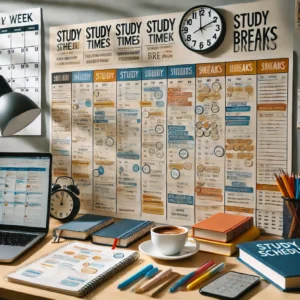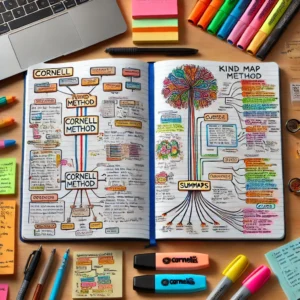Effective Study Techniques for Teenagers
Choosing the right study technique for each subject can make a significant difference in a teenager’s academic performance. Here’s a list of recommended study techniques tailored to different types of subjects:
Math and Exact Sciences
- Problem-Solving: Practice exercises and problems similar to those on the test.
- Concept Maps: Use diagrams and concept maps to understand and connect ideas.
- Group Study: Form study groups to address doubts and explain concepts to others.
Natural Sciences (Biology, Chemistry, Physics)
- Summarizing and Highlighting: Summarize chapters and highlight key points to consolidate information.
- Flashcards: Create flashcards with terms and definitions to memorize concepts.
- Experimentation: Conduct practical experiments and visualize processes to enhance understanding.
History and Social Sciences
- Timelines: Create timelines to visualize historical events in chronological order.
- Active Reading: Highlight, take notes, and ask questions about reading material.
- Discussion and Debate: Discuss topics with peers to deepen understanding and critical analysis.
Languages and Literature
- Close Reading: Read texts multiple times to grasp main ideas and details.
- Outlines and Diagrams: Organize information into outlines or diagrams to visualize text structure.
- Text Analysis: Analyze characters, plots, and recurring themes for deeper comprehension.
Foreign Languages
- Immersion: Listen to music, watch movies, and read in the language being learned.
- Conversation Practice: Join language exchanges or conversation classes.
- Flashcards and Apps: Use flashcards and mobile apps to practice vocabulary and grammar.
Art and Physical Education
- Consistent Practice: Regular practice is essential in practical disciplines like art and physical education.
- Technique Study: Research and study different techniques and styles.
- Self-Evaluation: Record yourself or self-assess to identify areas for improvement.
Technology and Computer Science
- Practical Projects: Develop projects to apply theoretical knowledge.
- Online Tutorials and Courses: Use online resources to learn new skills and solve problems.
- Continuous Practice: Regularly practice programming and software use.
Selecting the appropriate technique depends on the subject and the student’s individual learning style. It’s important to try different methods and adjust them based on personal needs and preferences.
How to Create a Weekly Study Schedule for Teenagers
Identify Your Tasks and Responsibilities:
- List all your subjects and pending tasks for each.
- Include extracurricular activities, free time, and other responsibilities.
Set Priorities:
- Classify tasks by urgency and importance.
- Focus on the most important tasks and those with upcoming deadlines.
Allocate Study Time:
- Assign specific time blocks for each subject.
- Include time for review and practice.
Incorporate Breaks:
- Schedule regular breaks to avoid fatigue.
- Use techniques like Pomodoro to structure study and rest periods.
Be Realistic and Flexible:
- Ensure the schedule is achievable and leaves room for unexpected changes.
- Review and adjust the schedule weekly as needed.
Time Management Techniques for Teenagers
Pomodoro:
- Method: Work for 25 minutes straight (a “Pomodoro”) and then take a 5-minute break. After four Pomodoros, take a longer break of 15-30 minutes.
- Benefits: Helps maintain focus and prevents mental burnout.
Time Blocking:
- Method: Divide the day into dedicated time blocks for specific tasks. Each block is reserved for one activity, minimizing distractions and multitasking.
- Benefits: Enhances organization and productivity by assigning specific times for each activity.
- Apps and Tools for Time Management for Teenagers
Trello:
- Description: A project management app that lets you create boards, lists, and cards to organize tasks.
- Benefits: Visualizes project progress and keeps tasks organized.
Todoist:
- Description: A task list and project management tool that allows you to set priorities and deadlines.
- Benefits: Simplifies daily task organization and progress tracking.
Forest:
- Description: An app that encourages focus by growing a virtual tree while you stay off your phone.
- Benefits: Reduces phone usage and helps maintain concentration during study sessions.
Focus Booster:
- Description: A Pomodoro-based app that includes a timer and time-tracking features.
- Benefits: Helps implement the Pomodoro technique and analyze time usage.
Google Calendar:
- Description: An online calendar that lets you schedule events, reminders, and time blocks.
- Benefits: Simplifies weekly schedule organization and syncs events across all devices.
RescueTime:
- Description: An app that monitors device usage and provides detailed reports.
- Benefits: Identifies distractions and improves time management.
Using these strategies and tools can significantly enhance organization and efficiency, helping teenagers better manage their time and achieve academic success.

Note-Taking Methods for Teenagers
Cornell Method for Teens
The Cornell method, developed by Walter Pauk at Cornell University, is an effective technique for organizing and summarizing information. It’s divided into three sections:
Notes Section (Main Notes):
- Occupies the right-hand side of the page (approximately 70% of the space).
- Write notes during class or while reading, using full sentences, abbreviations, or key phrases.
Summary Section (Cue Column):
- Located on the left-hand side of the page (approximately 30% of the space).
- After class, write key questions, keywords, or phrases summarizing the main notes.
- Serves as a quick guide for reviewing and recalling the content.
Summary Section (Bottom of the Page):
- At the bottom of each page, write a brief summary of the main ideas.
- Helps consolidate information and highlight key points from the lesson or reading.
Mind Maps and Concept Maps for Teens
Mind Maps:
- Description: Mind maps are diagrams that represent ideas, words, tasks, or other concepts linked and arranged radially around a central idea or keyword.
- How to Create:
- Place the main idea in the center of the page.
- Draw branches extending from the central idea, each representing a sub-idea or related concept.
- Add more branches to break down sub-topics further.
- Use colors, images, and symbols to make the map more visual and easier to remember.
- Benefits: Stimulates creativity, enhances memory retention, and visualizes relationships between concepts.
Concept Maps:
- Description: Concept maps are diagrams showing relationships between concepts using links and connectors.
- How to Create:
- Write main concepts in circles or boxes.
- Connect related concepts with lines and label them with words describing the relationship.
- Arrange concepts hierarchically, with the most general at the top and specific ones at the bottom.
- Benefits: Promotes deep understanding, clearly displays relationships, and helps structure information.
Highlighting and Annotation Techniques for Teens
Highlighting:
- Description: Highlighting involves marking key parts of the text to emphasize important information and make review easier.
- How to Highlight:
- Read the entire text before starting to highlight.
- Use different colors for different types of information (e.g., blue for definitions, red for important dates).
- Highlight only keywords, essential phrases, and main concepts, avoiding entire paragraphs.
- Benefits: Quickly identifies important information and enhances retention.
Annotation:
- Description: Annotation involves writing notes in the margins of the text, summarizing key points, asking questions, or commenting on the content.
- How to Annotate:
- Write brief summaries of paragraphs or sections.
- Note questions that arise while reading.
- Make connections to other knowledge or subjects.
- Use symbols and abbreviations to save space.
- Benefits: Encourages active comprehension, improves retention, and facilitates more effective review.
Implementing these note-taking techniques can significantly enhance organization, understanding, and retention of information, making studying and learning easier and more effective for teenagers.

Exam Preparation for Teenagers

Study Strategies for Multiple-Choice Exams
Understand the Format:
- Familiarize yourself with the exam format and types of questions that will appear.
- Practice with previous exams to get a feel for the question style.
Careful Reading:
- Read all answer choices before selecting one.
- Ensure you fully understand the question before attempting to answer.
Eliminate Incorrect Options:
- Discard choices that are clearly incorrect.
- This increases the likelihood of selecting the correct answer from the remaining options.
Look for Clues in Questions:
- Sometimes other exam questions can provide hints or information to help answer tougher ones.
Manage Your Time:
- Don’t spend too much time on a single question. If unsure, move on and return later if time permits.
- Allocate your time to ensure you can review your answers.
How to Prepare for Essays and Written Exams
Understand the Topic:
- Ensure you have a thorough understanding of the topic and essay or exam instructions.
- Research and gather all necessary information before starting.
Planning:
- Create an outline or draft of the main points you want to cover.
- Organize your ideas logically and coherently.
Introduction and Conclusion:
- The introduction should present the topic and your main thesis or argument.
- The conclusion should summarize the main points and reaffirm your thesis.
Developing Ideas:
- Each paragraph should address one point or idea clearly tied to your thesis.
- Use examples, evidence, and relevant quotes to support your arguments.
Review and Edit:
- Leave time to review and edit your essay. Check grammar, spelling, and clarity.
- Ask someone else to read your work and provide feedback.
Mock Exam and Self-Evaluation Techniques for Teens
Mock Exams:
- Simulate real exam conditions for practice. Use timers and stick to time limits as if it were exam day.
- Use previous exams or practice questions to create mock tests.
Self-Evaluation:
- After completing a mock exam, review your answers and assess your performance.
- Identify areas where mistakes occurred and focus on improving them.
External Feedback:
- Ask teachers, tutors, or study peers to review your answers and provide feedback.
- Listen to their suggestions and work on areas needing improvement.
Set Goals:
- Establish clear and achievable goals for each study and self-evaluation session.
- Reward yourself for meeting your goals to stay motivated.
Continuous Review:
- Regularly review your notes and study material to keep the information fresh.
- Use spaced repetition techniques to reinforce long-term memory.
Implementing these strategies and techniques can significantly enhance exam preparation and performance, enabling students to approach different types of tests with confidence and efficiency.
See also: Teens with ADHD
